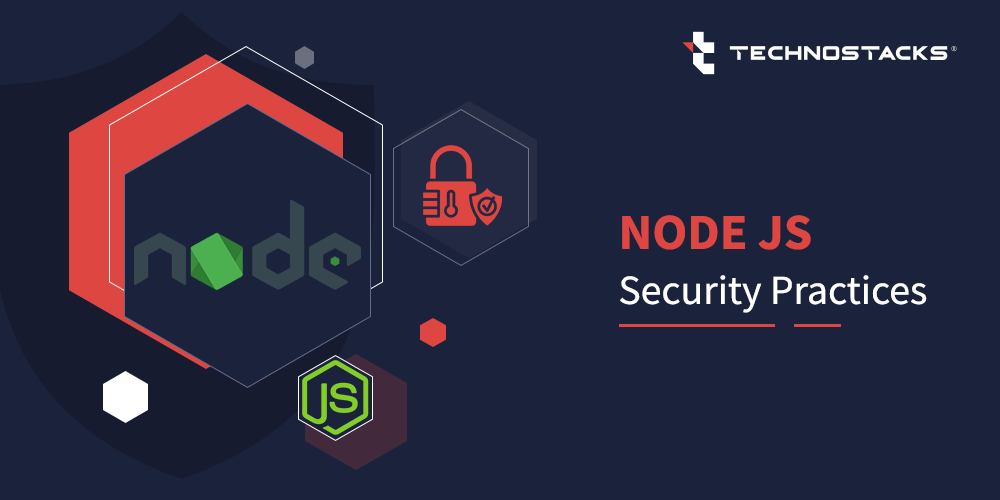Node.js Security Risks & Solutions
Node.js is proving to be an extremely popular platform these days primarily due to serving as the backend server for web applications. However, when it comes to the field of microservices, it becomes essential to consider Node.js security practices.
Not all security considerations are serious, and there are some best practices for securing the Node.js application.
- Validation of the user input for limiting the SQL injections and XSS attackSQL injection is precisely one of the well known attacks and it is one of the most common Node. js security issues. Every developer must have to consider the best Node.js Security Practices to resolve this issue.
The SQL injection attack usually happens when the hacker gets access to execute the SQL statement from the database. It becomes possible only when you don’t sanitize the input from the front end. It can also be referred to as the Node.js backend or parameter from the user-provided data and uses it directly as part of the SQL statement.
The basic idea that you will have to follow during these attacks is to never blindly pass the parameters from the front end to the database query. Rather consider validating or escaping the values that the user provides.
Besides, you can see that there are certain database libraries for node.js that are performing automatically. But you can always stick to using more generic libraries as a part of the Node.js web application security. At the same time, it is significant to note that cross-site scripting, which is also referred to as the XSS attacks, always works similarly to SQL injection.
However, there is a difference in the form that instead of sending the malicious SQL, the attack gets the opportunity of executing the JavaScript code. For fixing this issue, you will have to consider validation of the user input.
- Eradicating Brute force attacksWhen it comes to brute force attacks then the attackers always continuously try generating the random password. In this case, attackers consider deriving the password by generating millions of passwords until they find the right password. Certain records suggest that brute force attacks represent five percent of affirmed security ruptures.
Avoidance of such situations is essential for Node.js security. To get rid of such kinds of Attacks, you can consider using the bcrypt.js package that will guard the password whenever it is stored in the database. Besides, you can consider limiting the number of requests coming from a single IP.
Implementation of the maximum login attempts for every user is also very essential. With the utilization of Node.js best practices and tools, you can rest assured about setting the limit, after which the login attempt won’t be favored for a specific amount of time.
Also read:- Node.JS Frameworks
- Security against Denial-of-service attacksThe precise Node.js versions 4.0.0 to the 4.1.1 gave rise to a bug giving the scope to an attacker to trigger a denial of service by exploiting a bug in HTTP handling, resulting in a prematurely terminated process. In the case of denial of service attacks, attackers are always making many requests to a server. They do so by crashing it and also making it unavailable to the users. Considering the prevention of such attacks is mandatory.
You can do that with the help of the implementing limiting factor. Using that means that you can easily consider preventing such attacks with the limiting function that can always work for the limitation of the number of requests made by the user.
Using the limit body payload can ensure limiting the number of data sent in the body payload. The motive behind the same is to see that the load is never higher, which crashes the application.
- Preventing data leakYou just can’t rely on what you are getting from the front end, but do not rely on what data you will be conveying. You can just go ahead with easily sending all the information for the specific object to the front end and filter what will display there. Doing that is very simple as hackers always try finding the hidden data sent from the backend.
The solution that you will have to apply in this case is to only consider sending the information needed. In case you require the first and last names, make sure about just retrieved from the database. Many times it may happen that you have to do slightly more work but it is worth the time.
- The utilization of security lintersAlways consider scanning the vulnerability automatically that can eradicate security issues related to Node.js. Moreover, it also becomes possible for you to catch the basic security exposures even while you are writing the code.
Always make sure about utilizing the appropriate plugin that falls under the category of the linter. Again the type of security it will be giving you ensures a notification will pop up whenever you are just utilizing the insecure code practices.
Also read:- PHP & Node.js Development
- The utilization of the multi-factor authenticationAccording to certain companies, multi-factor authentication is 99 percent effective. Remember that the lack of authentication or broken authentication is responsible for making the system always vulnerable on many fronts. This is the key reason why the broken authentication is ranking as one of the major reasons for the vulnerability to attack.
Always make sure that you are eradicating the practice of the weak password or the session management policies. Always make sure about implementing strong passwords as well as consider multi-factor authentication at such times.
You will have to precisely consider several things for the implementation of the authentication flow like password creation and recovery policies, retry policies, session-id management, and similar others. Always it becomes very easy to leverage the already existing modern Node.js security practices.
Aside from leveraging the authentication, service providers also consider the two-face authentication that will be working as the best solution in-app with the packages that will help implement the two-factor authentication.
- Management of the old XMLExternal entities XXE attacks are quite common, and all of this always happens by exploring the vulnerabilities that the older XML processes pose. They allow the attackers to go with the external entities’ specifications and send them to the applications responsible for parsing XML inputs.
If the parser is weak in terms of its configuration, the attacker gets access to sensitive information, confidential data like the passwords in the server, and many other entities.
The easiest scope for getting access to the prevention of such attacks is just by disabling the parsing features in the library. You can get access to the security of your Node.js applications package that will be providing a bunch of the functions for the validation of the DTD and also helping in securing the apps against similar attacks.
- Eradicating the security misconfigurationThe diverse types of misconfiguration usually go on for plenty of time without getting noticed, which can be responsible for critical attacks. It happens because the app is always vulnerable to misconfiguration and weak protection most of the time. Around 73 percent of organizations have faced at least one critical security misconfiguration, leading to critical data and systems exposure.
Whenever it comes to Node.js development and configuration, always make sure about tuning them to all kinds of dependencies. Consider the database’s API external integrations.
Always it’s essential to consider the well-defined setup, distinct and separated from each other. Besides, it’s also good to consider storing the credentials in remote places apart from the project files.
There are certain cultural aspects of the company that are taking place. When you are using the logging tool, then the implementation of the policies is always mandatory. The Node.js developers will never consider logging in the sensitive data.
- Broken access controlAccess control enforces policies that specify that the users cannot act outside of their intended permissions. In this regard, the failures typically lead to unauthorized information disclosure. Besides, there are chances of modifying or destroying all data or performing a business function outside of the user’s limits. For getting access to the web application, hackers always use the vulnerability.
They do so to gain the strength of access into the users’ sensitive data as well as misusing or modifying it. Always make sure about ensuring the API is secure. At the same period, pay attention to the account authorization.
Ensure implementing the best Node.js Security practices that can ensure the prevention of the basic vulnerabilities, and for that, you can consider using the automated security test case.
Always pay attention to making both the authentication and the authorization implemented correctly so that can make sure about prevention of the user from logging into someone else’s account and stealing the data.
- Management of insecure deserializationThis is one of the major security concerns whenever the logic of the code finds tampering with the utilization of the unstructured data. Insecure deserialization is the hot spot for the hackers to always cause the dos attack, and they do so with the idea of exploiting the vulnerability.
For the prevention of the attacks that are caused due to insecure deserialization, the developer will always be requiring the prevention of the cross-site request forgery. Issues can be easily prevented by utilizing the cross-site request forgery token from the server where the web application is residing and planting it inside the form field. The form filled here is usually done at the client side.
- Eradicating Problem due to insufficient monitoringIt becomes imperative to consider that the web application is internally logged and monitor the activities as much as possible to prevent the hackers from getting access to the system and breaching your data. Also, pay attention to implementing the methods for causing the alerts and stopping them from controlling the server.
The utilization of the locking system can ensure you can keep tracking all the changes and activities going on in the web application. It will keep alerting you whenever unusual activity is detected. Whenever the unusual activity is becoming quite common, the utilization of the monitoring tools ensures the prevention of the vulnerabilities due to insufficient monitoring on the web application.
- Division of a solution by componentsIt is one of the difficult and complex things for large applications to maintain the huge code base with the terms of the dependencies. That said, there is always a chance of slowing down development while adding new features.
When it comes to the Node.js security best practices, it is always good to consider dividing the entire codebase into a smaller component so that every module is getting its folder. That being said, there would not be the vulnerability of the Node.js Security Risks anymore.
Key Takeaways
We have reviewed the best practices for Node.js Security applicable in 2021 and upcoming years. Securing and precisely safeguarding web applications is highly significant. However, people don’t put security measures in regular practices and forget to execute it at the required time because of the tight project deadlines.
To get better results, consider the Node.js Security solutions at every step of the software development life cycle to ensure there are no more security risks right from conception to production.
Technostacks is a leading Node.js development company and has an expert team of Node.js developers. Our team has enough knowledge of Node.js Security Practices. Contact us for more details.








